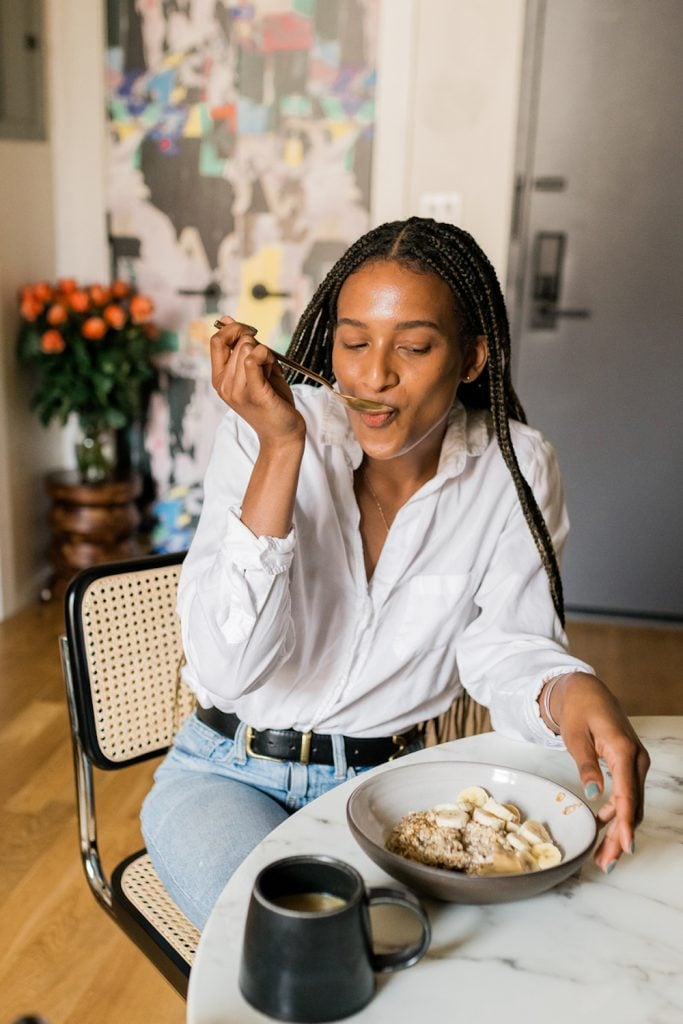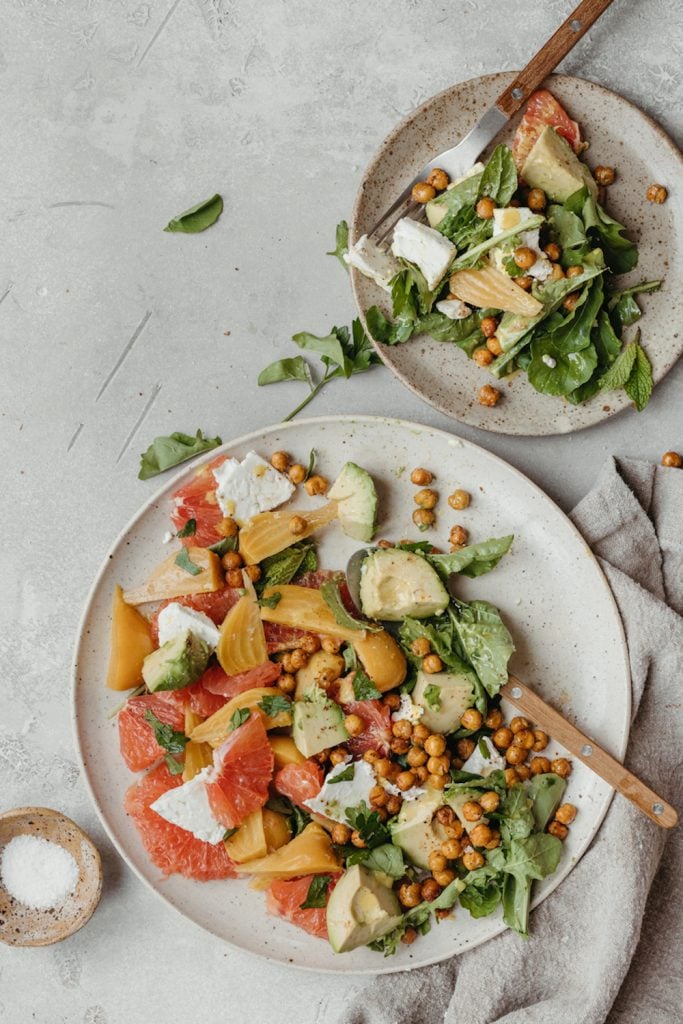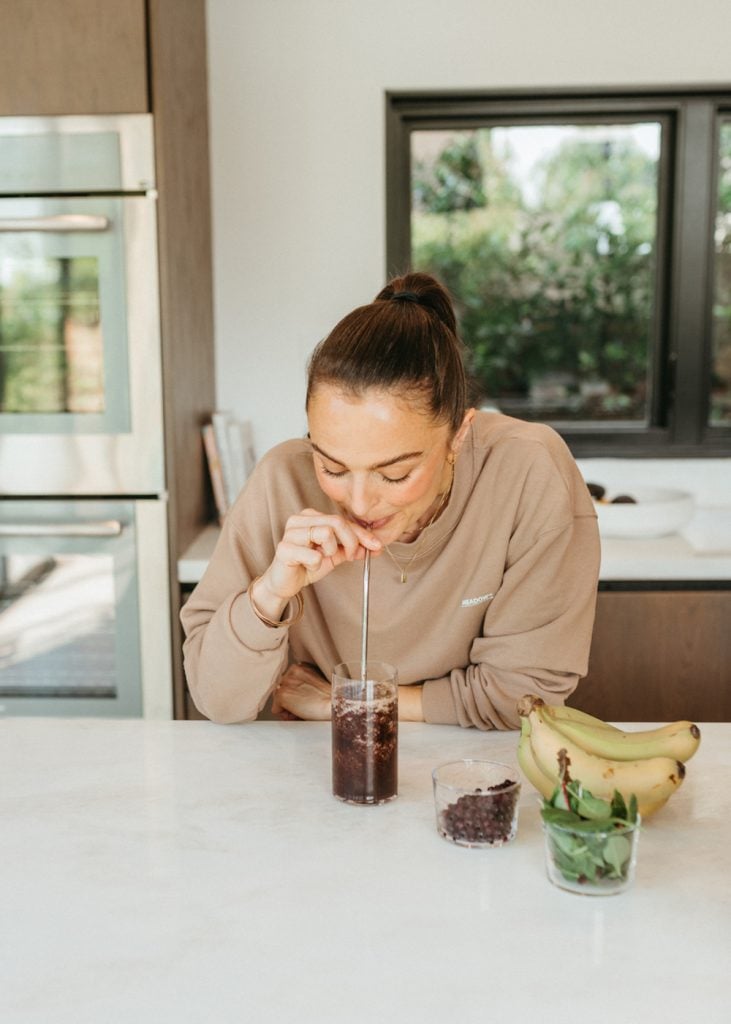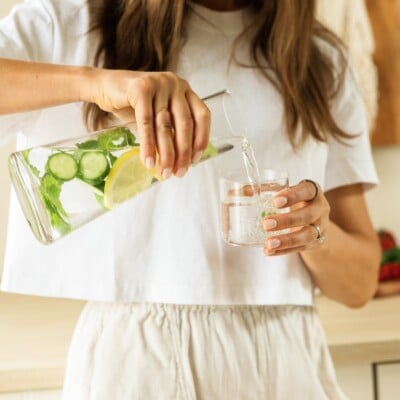For many people, women especially, it’s the million-dollar question: how to get rid of bloating. Let’s face it, even some of the world’s healthiest ingredients can leave us bloated. We fill our bellies with hearty lentil salads and nourishing grain bowls, only to realize our jeans feel extra snug after lunch. This common phenomenon is typically caused by bloat. And while bloating gets a bad rap, it’s akin to inflammation. We want some, but not too much.
Bloating happens to everyone—even health gurus and wellness enthusiasts. Even those who successfully avoid foods that cause bloat will get bloated. In fact, it’s estimated that one in 10 Americans experiences bloating regularly. If that’s you, don’t fret. Today, we’re explaining helpful tips to beat the bloat for more comfortable, confident days ahead.
Featured image from our interview with Megan Roup by Michelle Nash.



What is bloating?
Abdominal discomfort, like bloating and gassiness, isn’t limited to the occasional holiday feast. It can happen even if you haven’t eaten a large meal. That said, bloating and gas are usually tied to what and how you eat, so a few simple changes may help.
Ultimately, bloating is a combination of gas, air, and/or fluid retention in the stomach and intestines. When you’re bloated, you may feel as if there is no room in your stomach. Your stomach feels full, tender, and tight. In some cases, swollen. If you’ve experienced it, bloating can be both uncomfortable and painful. Often, your stomach may actually look bigger. When bloating occurs right after a meal, it usually resolves itself. However, it’s often possible to speed up this process. More on that, below.


Causes of Bloating
A variety of factors. As mentioned above, bloating happens when the GI tract becomes filled with air or gas. This can be caused by something as simple as eating certain foods or drinking carbonated beverages. Some foods produce more gas than others. Furthermore, a food intolerance or allergy—like lactose intolerance (problems with dairy)—can trigger bloating.
Bloating can also happen if you eat too much too fast. Beyond food, the menstrual cycle is another common cause of temporary bloating. Research suggests that changes in progesterone and estrogen levels cause the body to retain more water and salt. Thus, bloating.
How Not Eating Enough Can Lead to Bloating
On the flip side, not eating enough—or trying to fill up on low-calorie foods—can cause bloating. This is a two-pronged approach. First, many diets feature a disproportionately high amount of foods that require more energy to digest (think: raw vegetables and brassicas, like cauliflower and kale). Our bodies have to work extra hard to break down a ton of raw veggies. This results in bloating and gas. Secondly, for chronic under-eaters, the digestive tract slows down. As a result, food moves slowly through the body. It can feel uncomfortable. This explains a heightened sensitivity to feelings of fullness and bloating.


Why Some Healthy Foods Cause Bloating
Yes, even a healthy diet can cause gas! Colorful fruits and seasonal veggies do a body good, but sometimes, they’re not easy on the digestive tract. In essence, it all comes down to carbohydrates. Complex carbohydrates— those made up of more than one sugar until—are called oligosaccharides. And oligosaccharides are found in legumes, such as beans. While the bacteria in our guts love these oligosaccharides, they produce nitrogen gas, which we release as flatulence. It’s a normal side effect of eating legumes.
Furthermore, foods that contain complex carbohydrates—like whole grains and cruciferous vegetables—are also high in fiber. And a high-fiber diet can certainly cause excessive gas and bloating. Fiber goes undigested in the GI tract, so a buildup of gas can occur from fiber’s fermentation. If you’re suddenly eating more fiber than usual, you may feel it in your gut. Again, it should be temporary and is a normal part of loading up on more veggies.


Stress and Bloating
Beyond food, stress and anxiety can trigger bloating. Stress slows down digestion, causing bloating, pain, and constipation. It puts pressure on your stomach and abdomen. In turn, this upsets two things: hormone balance and neurotransmitter balance. This can create an environment where foods that are normally digested just fine end up being poorly digested, leading to gas and bloating. Stress can also lead to other digestive woes, like stomach ulcers and irritable bowel syndrome. At any rate, stomach bloating can be indicative of a more serious medical condition.
When to Seek Medical Attention for Bloating
While temporary bloating is common, if you’re troubled by bloating on a regular basis, talk to your doctor. A few signs and symptoms to be wary of:
- if you have persistent bloating, gas, or heartburn
- your stools contain blood or mucus
- there have been major changes to your bowel movements
- if your symptoms are making it difficult to function
Bloating can also be caused by impaired muscle function in the digestive tract. When muscles that normally move food along don’t work properly, gas can build up in the small intestines, causing bloating. In some cases, gas in the intestines may go the wrong way, returning to the stomach. Depending on what’s causing your bloating, surgery may be required to correct it. At any rate, it’s always best to seek medical attention if your bloating and gas is consistent and painful.


10 Tips to Beat the Bloat
Armed with an understanding of why bloating happens, let’s dive into simple tips to help beat the bloat.
1. Get in some gentle movement
Physical activity can get the bowels moving more regularly, which can help release excess gas and stool. Getting the bowels to move is especially important if a person is feeling constipated. A walk around the block can provide fast relief from gas pressure. Furthermore, certain yoga poses can position the muscles in the abdomen in a way that encourages the release of excess gas from the GI tract. This can reduce bloating.
2. Opt for peppermint oil
Peppermint oil capsules may also be helpful for indigestion and related gas. Manufacturers usually market them as a treatment for the symptoms of irritable bowel syndrome (IBS), but people without IBS can also use them to relieve bloating.
Peppermint works by relaxing the intestinal muscles, which allows gas and stool to move along more effectively. People should always follow the instructions on the packet. Anyone who is prone to heartburn may need to avoid peppermint.


3. Give digestive enzymes a whirl
If you’ve been diagnosed with an enzyme deficiency or digestive disorder, then digestive enzymes can help relieve gas and bloating. Even without a diagnosis, many people benefit from taking a digestive enzyme with their meals. My top three favorite digestive enzyme companies are Source Naturals, Pure Encapsulations, and Mary Ruth’s.
4. Try an abdominal massage
Massaging the abdomen can help to get the bowels moving. A massage that follows the path of the large intestine is especially helpful. People can follow the steps below to do this:
- Placing the hands just above the right hip bone.
- Rubbing in a circular motion with light pressure up toward the right side of the ribcage.
- Rubbing straight across the upper belly area toward the left rib cage.
- Moving slowly down toward the left hip bone.
- Repeating as necessary.
If the massage causes any pain, discontinue immediately.


5. Take a warm bath
The heat of a bath can provide relief for a sore abdomen. Relaxation can also reduce stress levels, which may allow the GI tract to function more effectively and help reduce bloating. For added relaxation and benefits, add lavender epsom salts to the bath.
6. Slowly add in fiber-rich foods
Eating more fiber helps prevent constipation and bloating. However, bear in mind that eating too much fiber or increasing fiber intake too quickly can cause even more gas and bloating. When increasing fiber intake, start slowly and allow the body to adjust to this change.
7. Swap carbonated beverages for infused water
Fizzy, carbonated drinks contain gas that can build up in the stomach. The carbon dioxide that makes soda and similar beverages fizzy can also cause bubbling and bloating in the stomach. Instead, drink water! We have plenty of ideas to supercharge your water.


8. Toss the sugar alcohols
Sugar alcohols in gum, packaged snacks, and protein bars can cause bloating. These are hard for the GI tract to digest (our bodies can’t digest most of them!), which can lead to discomfort. Swap sugar alcohols for more digestive-friendly sugars, like raw honey and maple syrup.
9. Consider a probiotic
We need good bacteria in our gut. Hello, probiotics! Taking a probiotic supplement may help to regulate the colon bacteria that can produce gas and cause bloating.
10. Keep a food diary
Rule out foods that cause discomfort with a food diary. After all, food intolerances are responsible for many cases of bloating. They can lead to excessive gas in the digestive tract. For people whose bloating happens after meals, keeping track of food and drink intake for several weeks should help determine whether specific foods are responsible.


Foods That Help With Bloating
In addition to the tips above, there are a few key foods to prioritize if you’re wondering how to get rid of bloating.
- Cucumbers. High in water and may alleviate bloating caused by dehydration.
- Yogurt. Packed with probiotics—a beneficial type of bacteria that plays a key role in gut health.
- Berries, seeds (chia and ground flax), and apples. Each of these are excellent sources of fiber.
- Ginger and turmeric. Bloat-beating herbs both known for their ability to soothe digestive distress.
- Green tea. Brimming with antioxidants and contains caffeine, helping stimulate digestive tract movement.
Click through for a few of our favorite anti-bloating smoothie recipes. They combine some of the superfoods shared above to help alleviate bloating. Happy sipping!
Tropical Turmeric Smoothie
Matcha Plant Power Smoothie
Strawberries and Cream Smoothie





